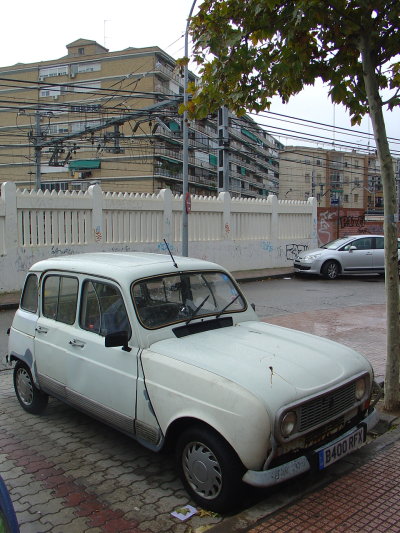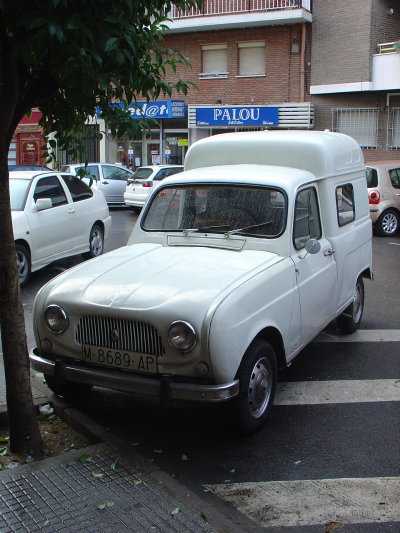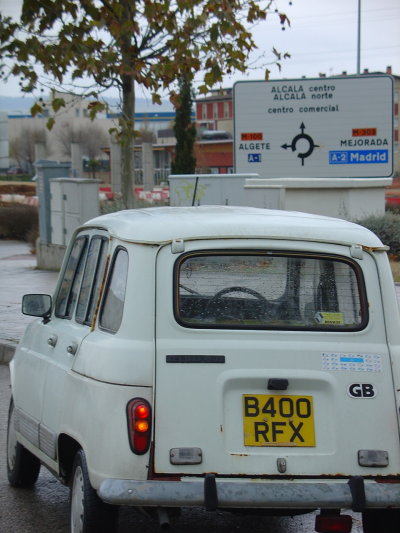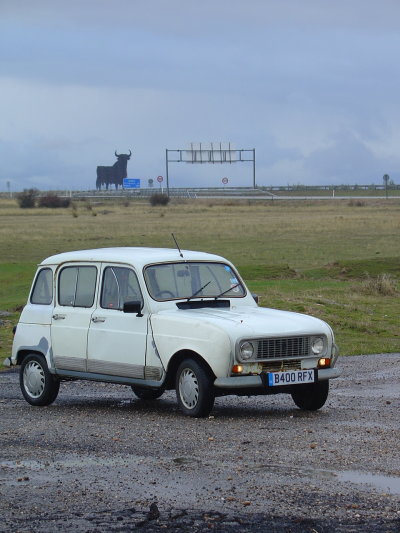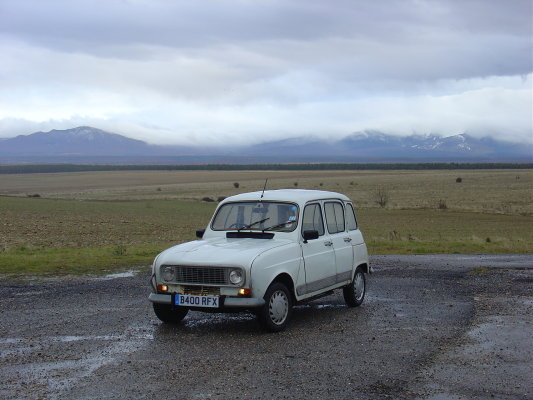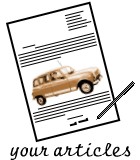
Rouen, Reflexia and the Open Road
page 1 of 5
by Peter Gumbrell, 22 December 2008
Here begins a five-part article, detailing an extensive and unplanned road trip made with Reflexia in December 2008. If you find this browser-based format difficult to read or you wish to print the story, you can also download a PDF version here.
In the late autumn of 2008, I was set to return to Rouen for furtherance of my French studies in the Normandy city. I had arranged to do another four weeks' worth of language courses, taking me up to Xmas and with the aim of finding longer term accommodation whilst I was there. I set off once again in my R4, taking the ferry from Newhaven to Dieppe, whereupon I quickly spotted the first other Quatrelle of my trip, a bright orange model that had probably been resprayed and was sitting on the roadside near a petrol station in the town. Over the next few days I was to see a few more around Rouen, during which time my own Reflexia sat in the garden of my host's home being rained on virtually non-stop.
On the first weekend in between my studies, I took the car out with a girl from my college, and we headed to the pretty port of Honfleur on the other side of the estuary from Le Havre, from where we had to cross the impressive Pont de Normandie, once the longest cable-stayed bridge in the world. This followed an incident in which we narrowly avoided a wild boar running out in front of us, further back near the banks of the Seine. Just two days later, however, I was forced to make a sudden decision about the near future, and to change my plans radically. With the college now likely being devoid of any further social activity until the spring, and upon the discovery of a much cheaper language school operating nearby and throughout France, I didn't waste any time in jumping in my R4 and exiting the city for, hopefully, less wet climes further south. Where exactly further south might I have been thinking? Presumably somewhere sensible and within relatively easy reach for an ageing R4 during these treacherous Europe-wide wintry conditions.
Like Madrid.
Yes, forever onwards preferring a spontaneous life full of unexpected surprises, and shunning the obvious to prevent the present situation becoming stale, I believed that driving all the way to central Spain from the northern fringes of France was a perfectly valid plan. Others didn't. But I don't listen to them. In fact, I have developed such absolute faith in the qualities and abilities of my dear Renault 4 that it never crossed my mind what a daft idea this might be.
So it was that on the morning of Tuesday 2nd December 2008, I set off at 8.30am from central Rouen on a road trip halfway across the continent. Exactly how things were going to pan out I wasn't sure. The only immediate objective was to reach Madrid as soon as possible, in order to meet up with a friend who was due to leave the city a few days later. After that, it was anybody's guess. With just a brief check of the tyres, lights, oil and water levels, I bundled all my luggage into Reflexia's boot and set sail southwards on an impromptu adventure.
An hour after leaving Rouen, the miserable and incessant rain that had plagued both the north of France and the rest of England, if not most of Europe during previous weeks, finally cleared as I steered towards Chartres, mapping out a route that would avoid any tolls and therefore make extensive use of often slower, single lane highways. The sun was at first a welcome change, but throughout the day it became an annoyance as my windscreen furred up with small particles reflecting its light and blinding my vision, and I realised that the course I had chosen drove me directly into the sun's beam as it crossed the sky from east to west. Initially, I was aiming south-east in the morning towards Chartres, but as the day wore on my trajectory changed to first south and then south-west, tracking the sun's rays in my face and leaving me with a small tan and vitamin D boost by the evening. The only other weather element distracting me was the strong crosswinds that hurtled across the plains and caused some unusual effects when passing lorries. I had driven through strong winds many times in an R4, but never until now had I experienced this phenomenon of so many knocking sounds and trapped air episodes that seemed to threaten to rip a panel off.
I found myself refilling after every 300 kilometres or so, sinking up to thirty euros of Super 98 into the tank on each occasion. My previous R4 forays into France, Belgium and the Netherlands have taught me that the standard Euro 95 version of unleaded, whilst perfectly adequate for my engine when consumed in England, appears to have a different octane level or quality from that sold in many other European countries, hence I tend to opt for the more expensive option wherever possible to avoid worrying pinking sounds and general sluggishness from the motor. Three refills later and with night descending on the ring road around Bordeaux, I was gearing towards an overnight stop on the farthest corner of France or nearest corner of Spain, but I hadn't counted on a monsoon arriving in my path before I got there.
As I will surely have documented somewhere on this site in the past, my driving expeditions of the previous twelve years have presented me with just about every torrential gale, storm, thick snow and ice and other extreme of European weather, as if in the form of some sort of test of my endurance. Yet still new tortures come my way, and what arrived that night was the biggest test I've ever faced. The rain was not so much bucketing down as falling in vertical rivers. For a period lasting around fifteen minutes, it seemed like I was driving my R4 through the never-ending bottom end of Niagara Falls. To make matters worse, the rain was at an acute angle aimed directly at my windscreen, and even with the wipers on full speed, the vision ahead was just a black blur. This stage of the journey was on a busy dual-carriageway, and a lorry in front provided my only visual cue as to where the road might lead. Its rear lights were just about discernible as I tried to keep a relatively safe distance, yet had to maintain an unnerving proximity for fear of losing sight of it. Of course, all the spray that this lorry generated only made things more difficult for anything in its path behind. No lane markings or other road features were visible at all, and within minutes the surface of the road had become inches deep in flash flood water. There were no slip roads at which to leave the carriageway, at least none that could be seen, and stopping on the hard shoulder would probably have proved the most dangerous thing I could have done, with other blind motorists behind liable to smack into me.
Fortunately, conditions eased a little and I exited the main road for a quieter one leading to Bayonne. The car had escaped unscathed, but some gaps still remaining around the seam of the front wing that I had fitted weeks earlier meant that water had sprayed in and soaked my trouser leg. I took refuge for the night in a FastHotel in Biarritz, thirteen hours after setting off from Rouen and covering the length of France north to south. Alas, by the time I went searching for food with little petrol and little visible action in this resort town on a windy, cold, wet Tuesday night in December, I could find nowhere still open. Unwillingly, I replenished my stomach with some tinned provisions from my bag back at the hotel, but which I had to eat with my fingers!
The next morning, I became further infuriated by this French town and its nation's fussy culture, whereupon it was impossible to find a filling station which was either open or which accepted foreign credit cards. One automatic pump at an Intermarché supermarket refused my card and staff inside offered no other possibility for payment, not even cash. I'd discovered this situation in France years before, but it was the first time I'd had problems during this visit. My fuel gauge was showing empty and I drove around for an hour becoming ever more desperate and worried. I'd never let the needle go this low before, although this circumstance was set to be the first of many such experiences during my travels. Finally, I located a garage back near where I'd started, but I didn't escape Biarritz until 11am, and I had originally advised my friend in Madrid that I would try to reach her by the end of lunchtime.
Once I entered my first péage section at the border of Spain, the landscape changed dramatically from the endless flat pastures of western France, into rugged Pyrenean hillsides and clustered Basque communities crammed into the spaces in between, amidst dozens of high-rise blocks. I faced one slight hitch in my day's mission: I had no road atlas or other map of Spain. Since they were so expensive to buy in the service stations, I decided to merely look at one and try to contain its details in my memory. The itinerary seemed simple. Just stick to the A1 and follow signs for Vitoria, Burgos and Madrid in that order. The conditions I would have to endure along the route were another matter.
The motorway rises from the back end of San Sebastián, weaving around the hills and valleys at the foot of the Pyrenees, and climbing endlessly into mountains that became ever whiter and lonelier. Despite being a main autoroute - the A1 no less - speed limits were reduced to as low as 20km/h in places as the road took sharp turns upwards. Once up into the skies above, with thick snow lying all around and continuing to fall, the road then takes several plunges up and down like an elongated rollercoaster, as one traverses one mountain range after another. The poor R4 was really up against it on this occasion. Most of the uphill sections have crawler lanes designed primarily for lorries, but open to other vehicles which cannot manage a minimum seventy kilometres per hour. Several times, Reflexia had to join the convoy of trucks as her speed was reduced to as little as fifty-five kilometres per hour. I've always found that this, my third Renault 4, has been more sluggish on the slopes than her forerunners, Angelica and Nicolexia. The latter of these had been tuned slightly differently by the former owner, meaning it was more racy but also much lighter to handle, to the point of sometimes feeling a little unsafe when skipping over bumps. The differences are only marginal and not attributed to any great feats of mechanical mucking about, just mild adjustments to what is already there. In contrast, Reflexia is more reliable, with a stiffer driving feel, but like a tortoise on the hills.
My friend was awaiting my arrival with some trepidation, since all the nation's news and weather forecasts had been consumed in recent days by bulletins about the severe snowfall and dangerous conditions affecting all of north and central Spain. The advice being dispensed was not to travel where possible, and with a bank holiday weekend looming there looked like further chaos was due to hit the roads. It flew in the face of conventional expectations to travel through France in clear blue skies and sunshine for most of the journey, only to then hit extreme cold, ice and snow upon arrival in Spain. It wasn't just the mountainous regions of the north that were experiencing such unusually brutal temperatures, the rest of Spain was frozen too. Add into this mix the rather unfortunate and unenviable condition whereby the heating system in my Renault 4 was only blowing out warm air when running at low speeds or for the first few minutes of driving. Some sort of thermostat problem has always presented this situation in Reflexia, although I seem to recall my previous cars had similar issues at times. Without any driving gloves, my hands were not best equipped for holding themselves up at the wheel for such long periods, but I pressed on regardless.
Once beyond Burgos, the mountains had levelled out into the high plains, and the end of my journey (or the first leg at least) finally seemed in sight. That was until a pair of police officers suddenly diverted traffic down a slip road and blocked off the motorway without warning. I now found myself in the middle of nowhere with no map, compass, GPS, sat-nav or other gadgetry, in the freezing cold, with the hot air of my breath forcing me to continually demist the windows to save letting colder air into the car through the vents. I tried to follow the lorries ahead, sure that they would also be heading in the general direction of Madrid and know the best way to get there. Just half a mile around the corner, however, they all pulled into a rest area and there seemed to be no other traffic in existence. I was perplexed, and lost. Taking a U-turn, I headed back under the carriageway in what I assumed to be a south-westerly direction, hoping to find a turn-off soon. With hope beginning to fade a few miles later, on endless plains running to the horizon, a tiny sign pointed in the direction of a narrow lane, simply reading 'Madrid'. Despite here being over one hundred kilometres off the capital, it seemed this city was the only place worth putting on a signpost in this region, and it was the one I needed. As I entered the lane, the name of the approaching small village was also displayed on a sign. It was called 'Canada'. Looking around at the scenery, that didn't seem too far from the reality.
The highway heading into the Madrid region began climbing again as I had to straddle more mountains, and as I rose past the red flags with stars proclaiming I had entered Madrid, I dived into the clouds and then into a tunnel that was full of this same cloud. It was virtually impossible to see anything. On emerging at the other end, I was only glad my journey wasn't in the opposite direction, as traffic had come to a standstill and was queued for a long way back. The opposite tunnel must have been so thick with the icy, murky air that the road was impassable or there had been an accident. Eventually, at around 4.30pm, I escaped all the snow and entered the busy freeways around the capital. All I knew from hereon was that the place I was heading - a city in the outskirts called Alcala de Henares - was to the north-east of Madrid, so I guessed my way across the north of the city and hoped for the best in picking a road going in the direction of Zaragoza. A quick call to my friend resulted in a change onto the A2 and my arrival in Alcala some forty minutes later, a day and a half after leaving Rouen.
The picture above was taken at the spot where I parked the car for the coming few days, outside the railway station in Alcala de Henares. It's hardly the most inspiring surroundings for a photo and doesn't give away much about where it could be, so I ensured I snapped another before leaving the town.
Whilst visiting my friend, I was rather surprised to pass a classic Renault 4 van parked in the town centre (below). It was an F4 that had the early front grille, and so would appear to be from the early Sixties. My friend believed its year could be ascertained from the number plate, although with the vehicle being older than her, she wasn't so sure what this year might be. Further pictures appear at entry number MC191 in the Mystery Cars section. I left a card on the windscreen, so if you happen to be - or know of - the owner, then get in touch.
After four nights spent in this authentic and attractive town, it was time to move on. Without having a Spanish road map at hand, my principal plan was to get out of Spain by heading northwards back to France. It had been my aim to take a short tour around some cities in the south of France in the new year, because I was keen to check out other study options for the future, so I now decided that I may as well bring part of that trip forward, and attempt to tie in a couple of the locations on my return through France. This would take me through Toulouse and Montpellier, possibly also heading onto Lyon after that. I already had the return ferry crossing from Dieppe to England booked for shortly before Xmas, but I could bring that forward a little rather than spend too much money travelling around. There was another option of taking the ferry from the north coast of Spain back to Portsmouth, but this was expensive, and I would be unable to obtain any refund on my Dieppe ferry due to the terms of the ticket. So the question now was which route to take in crossing the Pyrenees and reaching Toulouse?
It was tempting to pass through Zaragoza and onwards to Andorra, one of those small states that I've always wanted to visit just for the point of saying I've been there, but in this weather, on a bank holiday weekend, it was not advisable. A route to the east of the mountains was too long-winded, and so it seemed that a reversal of my previous route would be the most viable option. I had attempted to contact my old friend and Renault 4 colleague Asier Castellano in San Sebastián, and just before setting off from Alcala I received an email reply from him. We arranged to meet in his home city that evening, putting further strain on me to reach a rather remote destination within a compact time frame, in a Renault 4.
Before exiting my surroundings, I took one more snap (below) just to prove that my Reflexia really did make it all the way to Madrid at the ripe old age of twenty-four.
Unlike the heavy snow of days before, I instead had to drive through another deluge until I'd passed by the flags with the stars and exited the surroundings of Madrid, whereupon it turned clearer. As I passed one giant black bull hoarding after another, I was determined to find one with a stopping place nearby, where I could take a photo of the R4. My friend in Alcala had been telling me how the constructions had originally been erected decades ago for an advertising campaign which used the symbol for its branding. Some of them are enormous and tower over the motorways with a powerful and ominous presence, such that they have become iconic objects held dear by much of the population, who frequently sport much smaller stickers of the same symbol on their boot lids. Apparently, the current Spanish government had wanted to have them removed, but public protest had won them a stay of execution.
Somewhere between Madrid and Burgos, I found a spot to stop and get my prize photo (below).
It was at this same spot that I snapped the picture below, looking in the opposite south-easterly direction, towards the mountains shrouding the northern fringes of the Spanish capital.
From here on until reaching the Basque capital, the journey was less eventful as night fell and, unsurprisingly, I found the drive down through the mountains much easier than the climb going the other way. The final section as the road enters the urban sprawl between Vitoria and San Sebastián was a most enjoyable ride, as I hurtled around the winding valleys on a downhill run rivalled only by the best ski slopes. The snow had all but gone, and the down carriageway takes a more direct route than its twisty-turny uphill 20km/h counterpart. My only instruction from Asier was to take the first turn-off signed Ondaretta, and then pull over into the car park of a hotel named the Hesperia. Once I arrived, Asier came to meet me on one of his motorbikes, and we finished off the night with a couple of beers in the local bar. It had been over five years since the Interrail trip during which I had met up with Asier and his friend Luis, the other R4 fan from the city. On this bank holiday occasion Luis was out of town, but Asier did his very best to fit me in around his holiday plans. We arranged to meet the next morning at the edge of the bay, and he hinted that if the weather held out and there was no rain, he might just bring along his classic 1960s Cuatrolata for me to see.
<< previous article | next article >>
